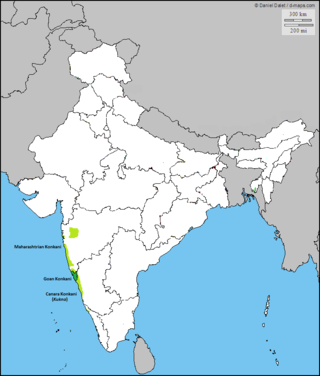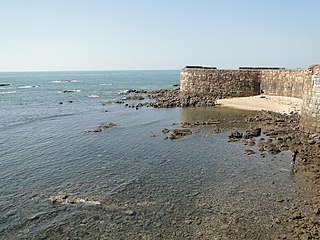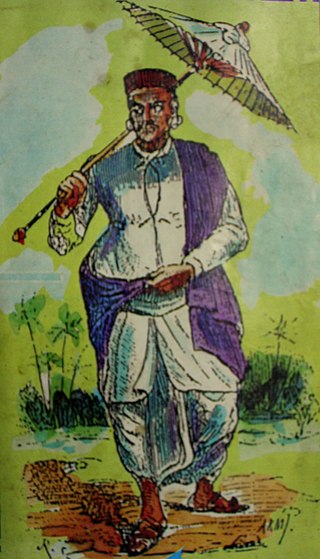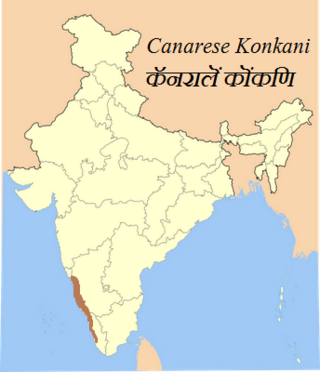
The Konkan is a stretch of land by the western coast of India, bound by the river Daman Ganga at Damaon in the north, to Anjediva Island next to Karwar town in the south; with the Arabian Sea to the west and the Deccan plateau to the east. The hinterland east of the coast has numerous river valleys, riverine islands and the hilly slopes known as the Western Ghats; that lead up into the tablelands of the Deccan. The region has been recognised by name, since at least the time of Strabo in the third century CE. It had a thriving mercantile port with Arab tradesmen from the 10th century. The best-known islands of Konkan are Ilhas de Goa, the site of the Goa state's capital at Panjim, and the Seven Islands of Bombay, on which lies Mumbai, the capital of Maharashtra and the headquarters of the Konkan Division.

Konkani is an Indo-Aryan language spoken by the Konkani people, primarily in the Konkan region, along the western coast of India. It is one of the 22 scheduled languages mentioned in the Indian Constitution, and the official language of the Indian state of Goa. It is also spoken in Karnataka, Maharashtra, Kerala, Gujarat as well as Damaon, Diu & Silvassa.
Saraswat Brahmins are Hindu Brahmins, who are spread over widely separated regions spanning from Kashmir and Punjab in North India to Konkan in West India to Kanara and Kerala in South India. The word Saraswat is derived from the Rigvedic Sarasvati River.

Sindhudurg district is an administrative district of the Konkan division in India, which was carved out of the erstwhile Ratnagiri district. The district headquarters are located at Oros. The district occupies an area of approximately 5,207 km2 and has a population of 849,651, of which 12.59% were urban. As of 2011, it is the least populous district of Maharashtra.
Malvani is a dialect of Konkani with significant Marathi influences and loanwords. Although Malvani does not have a unique script, the Devanagari script is used by most speakers. Malvani is sometimes used for sarcastic newspaper articles and local folk stage dramas known as Dashavatar.

Nerur is a town of Kudal Taluka of Sindhudurg district of Maharashtra in India. It is one of the smaller towns in the district having 32 wadis. The Malvani dialect of Konkani is spoken here. Nerur is becoming an attraction amongst Indian and foreign tourists from Mumbai and Goa.
The Konkani people are an Indo-Aryan ethnolinguistic group native to the Konkan region of the Indian subcontinent who speak various dialects of the Konkani language. Konkani is the state language of Goa and also spoken by populations in Karnataka, Maharashtra, Damaon and Kerala. Other Konkani speakers are found in Gujarat state. A large percentage of Konkani people are bilingual.
Sawantwadi is a taluka in the Sindhudurg district in the Indian state of Maharashtra. The taluka headquarters is Sawantwadi which has a municipal council, which is a local civic body. Sawantwadi was formerly the capital of the Kingdom of Sawantwadi, ruled by the Sawant Bhonsle royal clan of the Marathas.
Malvan is a town and taluka in Sindhudurg District, the southernmost district of Maharashtra State, India, well known for the historically important Sindhudurg Fort. Malvan taluka consists of villages such as Angane Wadi, Masure, Achra, Khalchi Devli, Jamdul, Juva, Pankhol, Talasheel, Bandiwade and Sarjekot. The main occupation here is fishing and agriculture. The staple diet of the local people is fish curry and rice. The town produces Alphonso mangoes and is also known for sweets such as Malvani Khaja made from gram-besan flour and coated jaggery as well as Malvani Ladoos. Other sweets that attract tourists are Konkani Meva, Aambawadi, Fanaspoli, Kajuwadi, and Naralachya Wadya.
Gaud Saraswat Brahmins (GSB), also known as Shenvis are a Hindu community of contested caste status and identity. They primarily speak Konkani and its various dialects as their mother tongue.

The Daivadnya,, is a community from Goa and Karnataka, who claim to have descended from Vishwakarma. Although they claim themselves to be Brahmin, but these claims are not accepted by others including local Brahmin castes. They are native to the Konkan and are mainly found in the states of Goa and Damaon, Canara, coastal Maharashtra, and Kerala. Daivadnyas in the state of Maharashtra and Karnataka are classified by National Commission for Backward Classes as an Other Backward Class.
The Marathi—Konkani languages are the mainland Southern Indo-Aryan languages, spoken in Maharashtra and the Konkan region of India. The other branch of Southern Indo-Aryan languages is called Insular Indic languages, which are spoken in Insular South Asia.

Asoli is a small village in Taluka Vengurla and district Sindhudurg of Maharashtra, India.

Christianity is a minority religion in Maharashtra, a state of India. Approximately 79.8% of the population of Maharashtra are Hindus, with Christian adherents being 1.0% of the population. The Roman Catholic archdiocese whose seat is in Maharashtra is the Roman Catholic Archdiocese of Bombay. There are two different Christian ethnic communities in Maharashtra: the Bombay East Indians, who are predominantly Roman Catholic, and the Marathi Christians, who are predominantly Protestant with a small Roman Catholic population.

Shri Gaudapadacharya Math, also known as Kavaḷē maṭha, located in Kavale, Ponda, Goa, is the oldest matha of the Smarthan Saraswat Brahman Samaj. It was founded by Gauḍapāda around 740 AD, whose student was Govinda Bhagavatpada, the guru of Adi Shankara, a highly influential figure in Hinduism. There is also a belief that Gauḍapāda himself established the Shri Gaudapadacharya matha when he lived in Gomantak (Goa). Thus, the matha came to be known as Shri Saunstan Gaudapadacharya matha. Unlike other mathas, Shri Gaudapadacharya matha is not a polemical center established to influence the faith of all Hindus, its jurisdiction is limited to only Dakshinatya Saraswat Brahmins. The Peetadhipathi "head monk" is Śrī Gauḍapadācārya. Smartist Goud Saraswat Brahman Samaj and Rajapur Saraswat Brahmin are its main disciples.

Canarese Konkani are a set of dialects spoken by minority Konkani people of the Canara sub-region of Karnataka, and also in Kassergode of Kerala that was part of South Canara.
Konkani is a southern Indo-Aryan language belonging to the Indo-European family of languages spoken in the Konkan coastal region of India. It has approximately 3.6 million speakers.

Madhva Brahmins, are Hindu Brahmin communities in India, who follow Sadh Vaishnavism and Dvaita philosophy propounded by Madhvacharya. They are found mostly in the Indian states of Karnataka, Maharashtra, Goa, Tamil Nadu, Kerala, Telangana and Andhra Pradesh.
The Rajapur Saraswat Brahmin (RSB) community, also called the Balavalikar Saraswat Brahmin (BSB) community, is a Hindu Smarta Brahmin community, which is found mainly in Maharashtra, Kerala and Karnataka. They are also known as Rajpuri or Rajapur.












